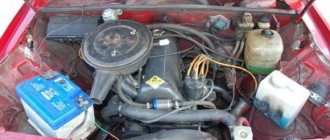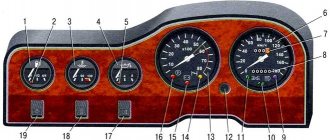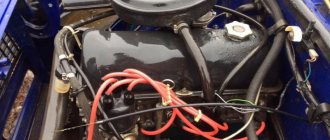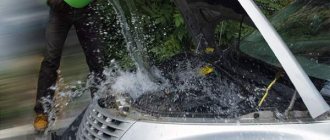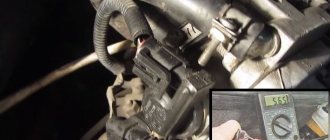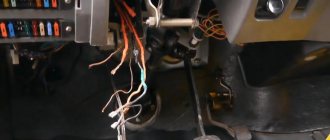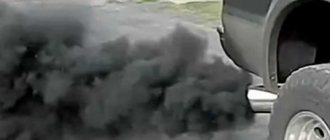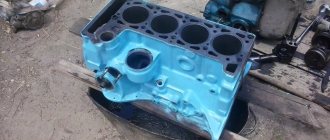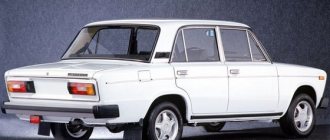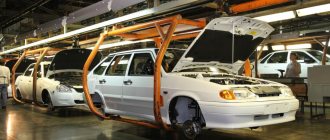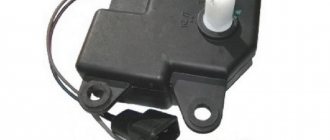During operation, the main indicators of the good condition of the internal combustion engine are the sound of the engine, the stability of the unit in different modes, the absence of problems with starting, etc. As for extraneous noise during engine operation, the appearance of various sounds may indicate the occurrence of certain malfunctions. These faults should be divided into two groups. The first includes breakdowns that do not pose a great threat to the main components and assemblies of the internal combustion engine itself. The second includes sounds that directly or indirectly indicate a high probability of serious engine failure, which leads to the need for major repairs or replacement of the existing power plant with a new engine, a used unit from a “donor”, a contract engine, etc.
We also recommend reading the article about what a contract engine is. From this article you will learn about the advantages and disadvantages of units of this type, and also find answers to questions about where and how to choose and then buy a contract motor.
There can be many reasons for engine knocking in the engine compartment, ranging from wear of drives or attachment rollers to knocking of valves, hydraulic compensators and other timing elements. As for the question of when there is knocking inside the engine itself, it could be the pistons, crankshaft, connecting rods and other components of the CPG. Let's take a closer look at the possible causes of engine knocking.
What is a knock in the internal combustion engine?
To begin with, we should examine such a simple concept at first glance as a knock in the engine.
This is the appearance of extraneous noise with a characteristic sound caused by the contact of various surfaces, parts and components of the motor. Often, if the engine knocks, this indicates symptoms of critical wear and gap formation. Characteristic unpleasant noises usually appear when the permissible gap sizes increase by 2 times or more. The force of impact and contact directly depends on the size of the gap.
That is, here we are talking about the collision of engine elements with each other. At the same time, during impacts, the load on the area where the components of the internal combustion engine are in contact increases sharply. This significantly accelerates wear and tear, and leads to the need to deal with repair issues in the very near future.
The increase in gap can be influenced by:
- initial gap size;
- engine parts;
- materials used;
- acting loads;
- efficiency of the lubrication system;
- performance of the cooling system;
- driving style, etc.
Because of this, some parts can knock, but at the same time withstand several tens of thousands of kilometers without causing any serious or dangerous consequences. This applies more to timing knocks. And others can cause a breakdown after 5-20 kilometers. Here, the most vulnerable elements are the cylinder-piston group and the crank mechanism.
There are even situations when the engine begins to knock, although the clearances remain normal and there is no severe wear. Similar symptoms may indicate:
- detonation and heavy loads on the engine;
- misalignment of engine elements;
- jamming of mechanisms;
- oil wear.
If you encounter knocking noises, they should never be ignored. Even when it seems that the car is behaving normally, the engine pulls and does not lose power.
Knocking noise at high speeds.
The reason why a knocking sound appears in the engine at high speeds is detonation. Detonation is the process of combustion of the fuel mixture in the cylinder earlier than expected. As is laid down in the operating principles of any automobile internal combustion engine, all work is based on 4 strokes. Ignition of the fuel must occur strictly at a certain point in time. Sometimes, ignition occurs ahead of time, that is, before a spark appears on the spark plug. At this moment, detonation occurs and, as a result, the engine knocks at high speeds under load.
Article on the topic: Correct density
Detonation can occur for several reasons
- low octane fuel
- early ignition
- unsuitable spark plugs
- heavy carbon deposits in the cylinders
Detansion is the main enemy of an engine, and especially an engine with a turbine.
How to determine detonation?
If you have a knocking sound in the engine that is expressed by a loud and ringing sound when you gain speed, then this is detonation. It appears when the engine is spinning up, and under heavy loads on it.
Cases when detonation occurs:
- During acceleration (at high speeds)
- When climbing uphill or when driving with a heavy load
- When the gear is too high for the current speed
Causes
Mazda tribute
If you conditionally divide the reasons, you will get two types - “easy” with which you can drive and “difficult” - after which your engine may not start.
Light knock
Mainly associated with engine wear or improper operation.
1) Oil. If you select the wrong oil, knocking noise may occur. For example, if you have a high-speed unit, but you have chosen characteristics for less high-speed types, lubrication will not be as effective, and therefore - hello noise.
2) Valves or hydraulic compensators may make noise.
Valve adjustment occurred mainly on older engines, for example on classic VAZ (from 2101 to 2107). In modern front-wheel drive models, the adjustment is automatic and occurs thanks to compensators, but they do not last forever, if they do not work, the engine will run noisily - we just change them.
3) Wear of the timing system. They can be either the rollers themselves (tensioners or guides), the whole point is that they have a bearing inside, which can fail over time - applicable to a system with a belt. And the chain can also knock, due to the fact that it is simply stretched, this happens, for example, on some TSI modifications. There is such a thing as a “diesel engine”, watch the video for information.
4) Development of the camshaft, valves, “pastel”. Knocking appears due to these reasons. The shafts, their fastenings, and the valves themselves wear down over time, and therefore operate noisily. This usually happens on a fairly worn engine.
The list could go on for quite a long time, there are cases that are out of the ordinary - this is water or sand getting into the lubricant, you also did not change the oil filter when changing the oil, but it was already clogged, etc.
All these causes of knocking are, in principle, solvable and with fairly “small” means. Usually it’s worth changing the timing system and the noise goes away. BUT there are knocks that indicate the death of your unit, and if you do not give them due importance, then it will simply break down completely. I classify them as difficult cases.
Complex knock
Well guys, there are also several reasons here and they are more difficult to eliminate. Some, it’s true, may be outside the block, but they are also at a high level in importance, I’ll start with them.
1) I had such a case in practice when a new VAZ 2114 knocked when starting up just horribly! The symptoms are as follows: turn the key and a metallic clanging sound of unknown origin occurs. An acquaintance got scared and called me; the car had only 1600 km on it. By the way, many people experience such a clanging noise on new cars, so guys, it’s not the engine – it’s the crown of the flywheel. When you try to start the engine, the starter, with its small gear, tries to spin the flywheel, and it also has teeth. Sometimes these teeth (crown) are poorly made or hardened and are frankly defective. Then the starter gear simply breaks them, and you hear a metallic grinding sound when starting. The flywheel needs to be changed! However, the process is labor-intensive - they remove the transmission to get to it.
2) Loose connecting rods. The connecting rod goes with the crankshaft, but it is attached to it through a detachable connection, which, as it were, covers the attachment point. It sits on two bolts; if one is not tightened, a distinct knock will be heard.
3) The piston itself breaks. Previously, this practically never happened, but now, due to the use of lightweight options, they appear much more often.
4) The most “terrible” knock refers to the crankshaft (CV). It lies in the block in special places. But it is not located entirely on the walls; special gaskets are placed under it - liners. They are made of very durable metal, and seem to cover the HF from above and below, in other words, two hemispheres. They are installed very firmly and the crankshaft cannot come out of them. So, it’s rare, but it happens that these “inserts” are screwed. This happens due to high wear or poor quality material. And then the liner begins to rotate along with the HF, the knocking will be terrible! However, it often gets stuck! The damage is very serious, you need to disassemble the engine, remove the crankshaft bearings, etc., the cost will be high. Here is an example of a broken bed.
4) Wear of the support liner. It supports the crankshaft from the front, that is, it holds it so that it does not go horizontally, and when worn, it will exhibit a strong knocking sound.
The engine knocks dangerously and not very much
Pajero mini
Taking into account the above, knocking can be divided into:
- strong knocking of the engine, which means it is necessary to stop using the internal combustion engine;
- weak engine knocking, which occurs as a result of natural wear of individual components or for other reasons;
Typically, the engine begins to knock not particularly strongly or periodically knock as a result of the mismatch of the engine oil for a given type of engine according to certain characteristics or after aging of the lubricant. The reason is obvious: engine parts are lubricated less efficiently, resulting in increased noise. You can also hear the knocking sound of hydraulic compensators or poorly adjusted valves. Hydraulic compensators begin to knock both due to poor oil and as a result of their own wear
Please note that on engines without hydraulic compensators, it is optimal to adjust the valves no later than every 20-25 thousand km
mileage
Also, knocking can appear as a result of problems with ignition of the mixture, which is detonation, glow ignition, and is also called dieseling on gasoline engines. The gradual deterioration of the camshaft, crankshaft, valve mechanism, etc. leads to an increase in excess noise on worn engines. In such situations, the engine may knock, but still work properly for quite a long time. It is often possible to eliminate the causes without a global repair of the internal combustion engine. In the worst case, you have to overhaul the cylinder head, change the drive rollers, chain, etc. Now let's talk about those cases when a knocking sound in the engine is fraught with serious problems.
Let's start with the most common symptoms. The list of the most common and dangerous engine knocks includes the following:
- knocking of pistons;
- the knock of connecting rods;
- crankshaft knock;
Typically, malfunctions of this kind are accompanied by a distinct metallic sound, which appears with a certain consistency or intensifies with increasing speed. Connecting rod knocking may also appear after unqualified engine repairs, since the bolts at the point where the connecting rod head is attached to the crankshaft may not be tightened sufficiently. Another common knocking sound is when the piston starts knocking. Piston knocking occurs when it is cold, but may weaken as it warms up.
Problems with the support liner, which limits the movement of the shaft in the horizontal plane, lead to severe runout of the crankshaft. Faults of this kind cause actual destruction of the internal combustion engine, as the crankshaft bed, the shaft itself and other engine elements are broken. If you hear distinct metallic sounds in the engine while the unit is running, then there is a high probability that the crankshaft is knocking. Remember, in this case, operation should be stopped immediately, as the engine may seize. The so-called “wedge” of the engine is the most serious malfunction, after which in some cases it is more advisable not to repair, but to completely change the engine. If the engine is still spinning, then there is a chance to get away with grinding/replacing the crankshaft and replacing the liners.
As a result, I would like to note once again that it is not only the engine that can knock. For example, a broken or defective flywheel crown will mean that when the driver tries to start the engine with the starter, he will hear a strong metallic grinding sound. If the engine is a chain engine, the stretched timing chain makes noticeable noise and knocks. The water pump (pump), air conditioning compressor, power steering, etc. can make extraneous sounds.
Motor diagnostics by ear: cutting off extraneous sounds
Engine noise can say a lot
It is important to remember that in order to correctly diagnose knocks and noises, the car’s power plant must warm up to 80–85 degrees after starting, otherwise the readings can be considered erroneous. It is best to take measurements not by ear, but with the help of a stethoscope, and preferably modern electronic equipment
Based on the nature and originality of extraneous knocks, it will be easy to determine a specific malfunction
It is best to take measurements not by ear, but with the help of a stethoscope, and preferably modern electronic equipment. Based on the nature and originality of extraneous knocks, it will be easy to determine a specific malfunction.
The sounds due to the weakened fixation of the engine to the body resemble the noise of a motor
Initially, the entire diagnostic process associated with the motor can be divided into several stages. The first of them, wiretapping, is what experienced car enthusiasts do, this is how experts begin their work, this is how beginners try to show what they know about cars.
And in general, the proverb incorrectly advises, at least in this case, “it’s better to see once”... In our case, it would be more accurate to hear once than to see a hundred times, i.e. face the problem head on.
The first thing to do when listening to sounds is to determine, or rather, prove that they are produced by the engine, and not by other components or elements of the car. For example, suspension components, hanging elements that have lost their former fixation, etc. often knock.
In the same logical way, you can remove from the list of causes some other sounds not produced by the internal combustion engine. For example, if you shake the power plant from below, you will be able to identify sounds that are associated with mounting the engine to the body or frame.
Sometimes the problem with fastenings is solved by welding metal corners
More interesting points:
- If there is a whistling or buzzing sound, doubts should fall primarily on the alternator or timing belt, camshaft drive or components in the pump area.
- The squealing most likely indicates problems with the belts (jumping), freezing of the pump, lack of lubrication in the generator, etc.
It is clear that by dismantling belts or other elements and filling in the amount of lubricating fluids, you can exclude them from the diagnostic analysis.
Thus, the first and most important thing that is done in the process of diagnosing an automotive power plant is to check its “environment”. The purpose is clear - this proves that sounds and knocks belong to the engine
To better understand the nature of problematic car engine sounds, we recommend that you familiarize yourself with them in more detail.
- The sound comes from the top of the engine, reminiscent of the ringing of metal. Typically, this metallic noise indicates problems with the valves. Most likely, this symptom indicates improper valve adjustment or excessive wear. If the noise increases as the speed increases, and even suddenly, the nature of the malfunctions indicates a much broader nature of the sounds - for example, it may be a matter of gaps.
Worn valves indicate an approaching overhaul.
- The noise is similar to the quiet friction of iron bars against each other. The sound changes as engine speed increases or decreases. The knocking comes mainly from the front end of the internal combustion engine. Most likely this is a symptom of a weakened timing chain. If the car is equipped with a chain and not a belt, an experienced car owner should be familiar with this sound.
- The noises are low-medium tonality, practically unchanged as the engine speed increases. As a rule, the sounds come from the bottom of the motor. This kind of knocking is more dangerous than others, as it indicates increased wear of the “internals” of the engine.
- Clanking, very loud. Appears more often when accelerating or maneuvering a car. In most cases, it indicates detonation knocks. The sounds are made by the pistons, which absorb the shock wave from the explosion of the combustible mixture. Among experienced car enthusiasts, this noise is usually called “finger tapping.”
Knocking in the engine - what to do Auto-moto
UAZ on tracks
A knock in an engine can occur for various reasons, but the main one is always the same: if there is a knock in the engine, it means that one part is hitting another, usually due to a violation of the clearance level. Depending on which parts are knocking and the gap between them, failure of the engine itself can occur quite quickly.
So, what could be the reasons for the knocking? Firstly, as mentioned above, due to the increased gap. This increase is most often associated with long-term use of the vehicle. Secondly, “crooked” parts can knock, that is, knocking occurs due to misalignment of parts. Typically, misalignment occurs due to mechanical impact on parts either from the driver or mechanics. Thirdly, parts that have a normal gap between them can also knock when the oil film breaks. Fourthly (but this is already exotic), parts with normal clearance can also knock, but then the reason is the deformation of one of the parts.
Let's take a closer look at the most common case - a non-standard gap. If you carefully analyze in which situations the knocking is louder and in which the knocking fades out, you can understand what exactly is wrong with the engine. The knock depends on three indicators: engine temperature, load and rotation speed. The knocking noise may get worse as the engine speed increases if the parts are already in very poor condition, but if the wear is minor, the noise from the engine speed will most likely drown out the knock. Engine load can affect the level of knocking in different ways. Depending on whether the knocking decreases or increases, faulty parts can be diagnosed. An increase in engine temperature can increase or stop the knocking and thereby provide additional data.
What to do if the engine knocks? First of all, do not panic; you must try to establish the cause of the knocking. After all, practice knows funny cases when a driver, incorrectly believing that the engine was knocking, sent it in for major repairs, but it turned out that the reason for the knocking was not in the engine at all. Therefore, it is necessary to listen to where it is knocking and how, under what conditions the knocking intensifies and when it decreases. What is all this for? To decide how to get to a car service station (although, of course, you can also go to a garage): on your own or with a tow truck. Experts say that in most cases it is impossible to continue driving when knocking noises appear, because this can destroy the parts even before the car gets to a specialist.
If it becomes clear how to get to a service station, it is important to find out which station repairs engines. Why? Because many diagnosticians have little idea of what mechanics know, so it will be difficult for them to make a correct diagnosis and even more difficult to make high-quality repairs
Therefore, you must put your car in the hands of only an experienced mechanic who can not only carry out correct diagnostics, but also carry out repairs at the proper level. Here you should always remember that having gotten away with minor repairs at non-specialized stations, you can calm down, lose vigilance and not notice how a small knock will develop into the need to make major repairs.
So, although engine knocking is dangerous, it can be dealt with with timely diagnosis and following simple tips.
Prevention
To avoid motor jamming and other problems, you should follow a number of simple recommendations:
- It is necessary to regularly monitor the level and condition of the engine oil, and also replace it in a timely manner. In addition to the lubricant, the oil filter also needs to be changed;
- Monitoring the coolant level will also protect against overheating. The volume of antifreeze in the expansion tank is checked with a cold engine;
- If there is knocking in the motor or other extraneous sounds, the movement must be stopped immediately, without waiting for the unit to stall on its own.
Thus, most of the reasons leading to jamming of engine elements can be prevented
This is a common problem, but if you take the time to care for your car and pay attention to the uncharacteristic behavior of the unit, you can avoid many problems
Signs of jamming
The engine will immediately signal a problem, and in this case movement is impossible. Often, when a malfunction occurs, drivers blame a dead battery, but charging it is not always able to fix the problem. There are certain symptoms that indicate a problem, which is jamming of motor elements.
This is often indicated by a click from the starter relay, after which the crankshaft stops rotating. The cause may be a dead battery or a malfunction of the starting mechanism. While driving, a sudden jamming of the engine can occur, then it immediately stalls, or a gradual loss of power, then the engine stops. It will no longer be possible to start the car again; the starter does not turn, and when trying to start the engine, a grinding and clanging of metal is heard. Sometimes, after inactivity, the unit still starts, but even if the startup is successful, if the problem is not resolved, you can no longer count on its normal and long-term operation. Often, before a jam, you can hear a rumble and the sound of metal parts hitting each other from under the hood.
Prevention
- Change the oil. To avoid the first or repeated engine seizure, check the condition of the oil and its level once a week, regularly change the oil filter and the oil itself. To check the oil for wear, a small part of it is taken out of the engine at operating temperatures, allowed to cool a little and see what condition it is in. If the oil does not emit an unnatural odor, it is transparent and slowly drains from the dipstick, then everything is in perfect order. But, if the oil becomes cloudy or has a dark brown color, this indicates the need for replacement soon.
- If you tap the motor, stop moving immediately. This can save you from more serious problems, such as a broken cylinder block wall. And this is a very major breakdown that cannot be solved on your own.
- Check the coolant level. To do this, you need to look under the hood and look at the amount of antifreeze in the expansion tank.
But this must be done according to special rules:
- Make sure the engine is cold. Because only in this state is all the antifreeze in the tank.
- Look at the indicators on the tank, they are usually labeled MAX and MIN. If they are absent, then if there is a sufficient quantity that does not require replenishment, the liquid level should not be below the middle of the container.
You will learn about the initial stage of repairing a jammed engine from this video:
Main reasons
Welding of liners with crankshaft journals due to oil starvation. Jamming of piston pins in the upper piston head. As with liners, the cause may be oil starvation. But the pin also jams due to misalignment of the upper head and piston pin. Due to the resulting misalignment, local zones of semi-dry friction and excessive tension appear, which can cause critical thermal expansion, scuffing and jamming. The piston is stuck in the cylinder due to engine overheating or poor heat dissipation. A broken piston blocks the movement of the connecting rod and the rotation of the crankshaft. Unqualified engine repair. Incorrect choice of thermal clearances when assembling the CPG, crankshaft, or unresolved malfunctions of the lubrication system can cause the breakdowns described above
Also, the cause of the wedge can be bolts and nuts accidentally dropped into the cylinders or intake tract. A bent valve blocks piston movement. The main reason for the “meeting” of valves with pistons is a broken timing belt
After a break or jump on several teeth of the timing chain at once and an impact, the valve stem bends. Severe deformation leads to the fact that the valve cannot move along the guide and blocks the movement of the piston on the approach to TDC. Valve desiccation will lead to similar consequences.
Mechanical wear
The main reason for the wedge in domestic cars is internal loose fastenings in the engine due to poor-quality lubrication and its non-periodic replacement. The nuts of the main bearings, timing belt tensioner, and connecting rod head nuts may become loose. After a makeshift overhaul, the retaining ring may come out of the piston. The reason for this is non-standard spare parts.
A crumbled valve can be checked visually by removing the engine cover. Often a spring flies out or the valve itself bends when the timing belt breaks. Malfunctions occur when the cylinder head is tightened without a torque wrench, when a crack appears in the walls due to overstrain and, accordingly, the pressure on the lubricant drops. The likelihood of engine wedge increases with excessive loads while driving.
How to find out what is knocking in the engine Auto magazine
How to find out what is knocking in the engine?
It's no secret that over time the engine wears out and, depending on its service life, malfunctions periodically arise that can lead to repairs.
As a rule, if you hear any extraneous knocking or noise in the engine, you immediately contact Opel services with a request to determine and eliminate the cause of the extraneous sounds. Well, what if there is no way to contact the service? Is it possible to determine the cause of extraneous noise or knocking in the engine?
Of course you can! And many car enthusiasts do this themselves in order to avoid expensive diagnostics when contacting a car service center. You can do this too and determine with sufficient accuracy the cause of extraneous engine knocks. In identifying extraneous engine knocks, a car stethoscope will come to your aid. In the absence of the above, you can resort to ordinary medical help. Or make a homemade device from available materials, for example, a plastic bottle, a piece of tube and an ordinary bolt.
Once you have decided on the choice of stethoscope, you can begin troubleshooting. Engine malfunctions due to wear and tear can be very different, and to know them exactly, you need to at least read the manual for your engine and know its structure. After all, without an exact understanding of what and how it spins and moves in your engine, what gears and bearings are installed in it and where they are located, no stethoscope will help you. But maybe you will be pleased that with the acquisition of some experience, you will be able to diagnose the engine no worse than any specialist from a car service center
Below are some faults that you can detect yourself and which you need to pay attention to first of all
The occurrence of knocking of the pistons in the cylinders.
This malfunction is typical for dull and clicking sounds when starting a cold engine when the accelerator pedal is suddenly released and the engine speed is reduced. When the engine warms up, the knocking noise usually disappears. Knocks can be clearly heard in the area of the cylinder block.
The occurrence of knocking piston pins.
A loud metallic knock will appear when you sharply change the throttle, decrease or increase engine speed. Probably the most common knock. May appear after filling with low-quality fuel. They can be heard in the area of the cylinder block, and disappear when the spark plugs are unscrewed, as the load on the piston disappears.
The occurrence of knocking noises from the main bearings.
They usually appear when the crankshaft liners wear out. They can be heard well in the crankcase area, like knocking with a well-defined metallic tint. They are especially clearly audible when the oil pressure in the engine crankcase is low. Therefore, never fill the crankcase with oil that is not recommended by the manufacturer. If you do fill it up and characteristic knocking noises begin to appear, then immediately change the oil to the recommended one and thoroughly flush the engine.
The occurrence of knocking of the connecting rod bearings.
It is characterized by the same knocking noises as the main bearings, but with a more pronounced character. If knocking noises characteristic of the last two subparagraphs occur, the engine may jam. Therefore, timely oil changes are recommended. There is no need to save on cost, but buy really high-quality oils from well-known brands. And one last piece of advice. Don't be discouraged if you couldn't immediately identify an engine malfunction based on extraneous noise. All comes with experience. You can contact a specialist and ask for help. Or go to the nearest car service center and see how they carry out diagnostics there. In any case - go for it! Learn! Experience will definitely come.
Also, look:
- Preparing your car for winter
- Muffler repair
- All about car radiator repair
- 5 “disadvantages” of an automatic transmission
https://auto-diary.ru
The engine knocks, what to do and how to determine the cause
The appearance of extraneous noises, creaks and knocks naturally occurs as the power unit and other components of the car wear out. One of the most alarming symptoms is a knocking sound in the engine, which can have a different tone (ringing, metallic, etc.), be obvious or muffled, appear only when cold or hot, be present constantly or disappear.
The appearance of engine knocking in most cases indicates that in the area of mating of certain parts there has been a critical increase in the gaps between the elements. If the systems
Specialists diagnose problem nodes by the nature of the knock, its tone and area of localization. A stethoscope is widely used for diagnosis. You can also make your own device for listening to engine knocks. To solve the problem, you will need a steel rod to which you need to solder a metal can. The bottom of such a container will effectively act as a membrane. To determine the cause of the knocking, the end of the rod is applied to various parts of the diagnosed internal combustion engine, while the can is pressed tightly against the ear.
The tone of the sound is an indirect sign, since on different engines the knock may appear louder or muffled. For example, the conventional knock of the crankshaft main bearings on a 1.4-liter Korean car may well be louder and easier to hear compared to the knock of connecting rods on a 3.0-liter German car. Often, the individual design features of each engine can cause a knock that has a different sound color, but the breakdown may be the same.
If we talk about diagnostics based on the nature of engine knocking, then it is worth highlighting a constant knocking, periodic knocking with one frequency or another, as well as occasional knocking. In the latter case, it is worth understanding the impacts that occur unevenly.
Engine knocking is usually associated with engine speed, that is, with the frequency at which the crankshaft rotates. The faster the engine spins, the higher the knocking frequency. The indicated frequency may or may not coincide with the crankshaft speed. It is also worth noting that the sound can become more or less intense (differ in strength) depending on the operating mode of the internal combustion engine.
For example, with an increase in the speed and load on the engine, there is a natural increase in the loads on the moving parts of the crank mechanism and the timing belt. In this case, the worn elements will knock more strongly than when the engine is idling.
At this stage, when diagnosing, it is important to determine whether the knocking increases with increasing speed. This often requires experience, since it is necessary to listen for knocking against the background of the general increasing noise of the operating unit.
In parallel with this, it is necessary to separately take into account the fact that the oil pressure in the engine lubrication system also increases with increasing speed. In some cases, the engine oil itself acts as a “damper”, and the knocking itself may become less intense even with increased load on the engine. For this reason, an important parameter is the temperature of the internal combustion engine. The engine may knock heavily when hot because the oil is diluted. At the same time, the knocking may hardly appear when cold. The opposite situation also happens when the engine knocks distinctly when cold, but after reaching operating temperature the noise disappears or is minimized.
Possible causes of engine knocking
It is worth noting that knocking may not progress at the same rate, that is, it may quickly or slowly intensify during operation. The list of main elements of the CPG, timing gear and crankshaft that can knock includes:
knock
The sound of a knocking piston in the cylinders is localized in the cylinder block, has a dull tone (reminiscent of the sound of knocking on pottery), and may also be accompanied by clicks. It most often appears when it is cold, as well as at low speeds and when the gas is suddenly released while driving. After warming up, the knocking sound of the pistons on a cold engine disappears, as the piston undergoes thermal expansion. Usually the piston knocks when a gap of about 0.3 - 0.4 mm appears.
Piston pin knock
The piston pins knock loudly and high in tone, the knock is clearly metallic. It is clearly audible when changing the gas, as well as at the moment of releasing the gas or pressing the accelerator to accelerate. The localization zone is the cylinder block. Usually appear when there is a gap of about 0.1 mm.
Additionally, a fault is diagnosed
Tough diesel operation
Previous13Next
One of the main features of the combustion process in diesel engines is the “hardness” of operation. Since in the initial period of the second combustion phase a significant amount of fuel burns at high speeds, a significant increase in gas pressure on the piston occurs. “Hard” engine operation refers to a working process in which the combustion pressure in the cylinder increases extremely quickly.
It would seem that the “harder” the work, the more power should be developed and the efficiency of the engine should improve, since under these conditions the losses associated with imperfect combustion dynamics should be reduced. However, this causes an increase in dynamic loads on the parts of the crank mechanism, the appearance of vibration and reduces the durability of the engine.
The “hardness” of engine operation is assessed by an increase in pressure per degree of crankshaft rotation angle:
The average value of the “hardness” of diesel engines (∆p/∆φ) avg is usually 1-1.5 MPa/°.
The operation of carburetor engines is also characterized by a certain “hardness”, but it is only 0.2-0.3 MPa/°.
The more fuel prepared for ignition is in the cylinder, the more heat is released in the second phase of combustion, and the greater the “hardness” of the engine.
When developing a diesel engine, they strive to ensure effective heat transfer with moderate “rigidity” of its operation, without exceeding permissible values.
An example of “hard” operation of a diesel engine is its operation during warm-up, especially at low ambient temperatures. Under these conditions, the auto-ignition delay period is prolonged, which leads to high values of ∆ p
/∆φ.
Expansion process
Purpose and course of the expansion process
The expansion process is the only process in the work cycle during which useful work is performed. It begins with the beginning of a decrease in pressure in the cylinder and ends when the piston reaches BDC.
Expansion occurs when the heat exchange surface area changes, as well as the pressure in the space above the piston and is accompanied by the loss of a small amount of the working fluid through the ring seals.
In the initial stage, expansion occurs with the supply of heat, since at this time afterburning ends and an increase in temperature is observed. Therefore, the value of the expansion polytropic exponent n
2 below the expansion adiabatic exponent k
2, in some cases even less than 1. As the piston moves to BDC, the afterburning process subsides and heat removal into the cylinder walls begins to predominate.
In this case, n
2 increases, approaching the value
k
2.
At a certain position of the piston, the heat removal and at the same time the continuing but weakening heat supply become equal: n
2 =k
2.
With further expansion, heat removal from the working fluid begins to dominate, and n
2 becomes greater than k
2.
Thus, expansion should be considered as a polytropic process with a variable expansion polytrope index n
2 (Fig. 20).
Rice. 20. Change in the process of expanding indicators T, p
,n
2 and
k
2.
Due to the difficulty of using variable values of n
2, when performing thermal calculations of engines, the conditional average value of the expansion polytropic index is used.
Depending on the type of engine and its operating mode, the average values of the expansion polytrope vary from 1.18 to 1.32.
When considering the influence of various factors on the expansion process, it should be borne in mind that the smaller the value of n
2, the flatter the indicator diagram will be, which means more useful cycle work will be obtained.
The expansion process is influenced by the following factors:
1. Crankshaft rotation speed. As the crankshaft rotation speed increases, the time of contact of the working fluid with the cylinder walls and gas leakage through the gaps between the piston and cylinder are reduced, which leads to a decrease in the value of n
2.
2. Load. In carburetor engines, as the load increases, the value of the indicator n
2 remains almost unchanged; in diesel engines this indicator decreases due to an increase in the afterburning phase.
3. Cylinder dimensions. At a constant cylinder displacement with increasing S/D
value of indicator n
2 decreases.
4. Combustion chamber design. As the size of the combustion chamber increases, heat removal from the working fluid increases, so the value of the index n
2 increases.
5. Technical condition of the engine. When the cylinder-piston group wears out, leakage of the working fluid increases, which is similar to heat removal. Therefore, in worn-out engines the value of the indicator will be higher than in engines in good technical condition.
Previous13Next
Date added: 2017-02-13; ; ORDER A WORK WRITING
What does knocked engine mean?
How can you tell by ear and what are the signs that the engine has knocked? Perhaps this is one of the few questions that is of great interest to inexperienced owners of used cars. Of course, a new engine can also knock, depending on how you handle it; this applies more to impulsive young people who “bought their license” but forgot to learn how to drive.
In this article we will look at different aspects and options for engine “knocking” on different brands.
For example, among the Japanese, the worst sound is the knock of the connecting rod mechanism when the bearings wear out. It will not be possible to fix it quickly, unlike our engines. Specialists manage to use very viscous oil, set the ignition later, put in “gaskets”, but they only do a major overhaul and that’s it. According to the Japanese, no two Japanese engines knock the same. Believe it or not, it's up to you. I personally believe it.
General questions and crankshaft knock
Signs that the engine has knocked. Everything is much more complicated with
and stronger due to the fact that during the stroke the pistons come close to the cylinder block, or rather its head. Over time, the piston will simply hit the block and make a dull sound. It is strictly forbidden to drive such a motor, otherwise prepare money for a new one. Of course, you can get a couple of kilometers home, but no more, and then with a Subaru engine and the EA-81.82 model.
The design of such a unit is strong and durable due to the short crankshaft. Remember, the cause of the knocking noise can be an arbitrarily unscrewed connecting rod nut, which can grind the engine floor. For a new power unit, the gaps between the connecting rods are 0.02 microns, and for a worn one, 0.07 microns. It would seem nonsense, but it plays a role.
What exactly jams in the engine and for what reasons
As a rule, the crankshaft jams. Or rather, its bearings. The piston jams less often. The main thing is that it is simply impossible to quickly answer the question of why the engine jammed.
The fact is that there are many reasons that can be divided into two main groups: mechanical damage and overheating.
Mechanical causes of internal combustion engine jamming
Foreign objects have entered the space above the piston or onto the piston head. This could be, for example, a missing/torn off nut. For example, the air filter mounting washer fell into the intake manifold, elements got into the intake when removing the carburetor, foreign objects could get directly into the combustion chamber, etc.
In this case, the piston jams, but not necessarily tightly. However, in most cases, serious repairs will be required to eliminate the consequences.
A broken or skipped timing belt or chain, as well as a broken timing chain guide and a fragment of it getting under the chain itself.
By the way, when the cause of jamming is a problem with the chain or belt, the valves become deformed (bent), which is why they cannot return to their seat. As a result, the piston cannot enter top dead center and the valve collides with the piston head.
- Piston pin outlet. This is fraught with the fact that the piston head will remain loose with all the ensuing consequences.
- Loose crankshaft main cap nuts or connecting rod lower head nuts. This can happen when, during engine repair, these nuts were not tightened properly (the tightening torque was incorrect).
By the way, if it is reliably known that foreign metal objects have entered the cylinders, they can be removed without completely disassembling the engine. To do this, you will need a magnet and a rod of sufficient length (for example, a knitting needle). Having raised the pistons of cylinders 1 and 4 to the top position, you need to unscrew the spark plugs and remove a metal object through the spark plug well with a magnet. If there is nothing in cylinders 1 and 4, then 2 and 3 should be checked in the same way.
Engine overheating
Many causes of engine seizure are associated with engine overheating. The most common of them are:
Lack of lubrication or low oil level. As you know, inside the engine itself, oil plays the role of not only a lubricant, but also a coolant.
- Coolant getting into the oil. Leads to the fact that the lubricating fluid loses its properties. Most often this occurs when the integrity of the gasket between the head and the cylinder block is damaged, but cracks in the cylinder head or cylinder head are also possible.
- Faulty thermostat or coolant pump.
Why the engine knocked - possible reasons
Let's start with the definition itself. Drivers often say that the engine is knocking or knocking. What does “engine knocking” actually mean? This formulation of the malfunction, as a rule, is understood by professionals and experienced amateurs to mean a change in the sound of the internal combustion engine precisely due to problems in the area of the central combustion engine, crankshaft and timing gear, which means the need for a major overhaul.
Note that not every driver can accurately identify such a knock. In such cases, inexperienced car owners say that the engine knocked, and the definition is applied in cases where any extraneous sounds of a shock or other nature appear during operation of the internal combustion engine. In other words, it is most correct to apply the definition of “engine knocking” precisely when there is knocking inside the engine, and not in the attachment or in the area of the attachment pulleys. We've sorted out the definition, now let's move on to the reasons themselves.
An internal combustion engine, regardless of what type of unit is under the hood (gasoline, diesel, hybrid or rotary), consists of many loaded components. Mechanisms and systems inside the engine (crankshaft, timing belt, etc.) form so-called friction pairs. A working motor should operate quietly, which means the integrity and normal interaction of all parts with each other, as well as the effective operation of the lubrication system.
The appearance of metallic knocks (metal hitting metal, clanging or grinding) is a reason for immediate cessation of operation and in-depth diagnostics of the engine to quickly identify the causes.
You should also pay attention to the nature of the knocks, taking into account individual characteristics:
- the engine knocks only when cold and/or hot;
- the sound appears at high or low speeds;
- Engine knocking occurs at regular intervals
- the engine knocks constantly, with the same force, loudly or dullly;
- knocking in the engine progresses (increases) or remains at the same level;
Let us add that an increase in the overall noise level can occur on its own, that is, it does not necessarily constitute a malfunction. This is true for engines with significant mileage, which are already worn out and cannot operate as quietly as new units. Also, knocking in the engine can occur as a result of engine overheating, the use of incorrectly selected or low-quality (counterfeit) engine oil, long-term operation of the engine when the recommended service interval for lubricant and oil filter replacement is significantly exceeded. For example, driving on oil without changing it for more than 20-25 thousand km. instead of the recommended 15 thousand km.
Why does detonation occur in engine cylinders?
Experts identify several main reasons why fuel detonates in the engine.
First of all, it is worth immediately highlighting the use of low-octane gasoline in units with a high compression ratio. Simply put, the octane number of gasoline (AI-92, 95 or 98) actually indicates its resistance to detonation, and not its quality, as many people mistakenly believe.
The use of fuel with an inappropriate octane number for a particular engine naturally leads to the fact that the fuel-air charge detonates under strong compression. Let us also add that simple engines that do not have an ECM and a knock sensor are at greater risk.
Engine coking
It is important to understand that modern engines not only in foreign cars, but also in domestic cars are very different from their analogues from the times of the USSR. In a nutshell, if the engines on the Moskvich 2141 model had a compression ratio of about 7 units and worked normally on any fuel, today the units have from 9 to 11 or more units
In this case, a decrease in the physical volume of the combustion chamber as a result of the formation of a carbon layer will lead to the fact that the fuel charge in the cylinder will be compressed more strongly, and detonation will appear. If we add to this the low quality of fuel at domestic gas stations, then the risks increase even more.
Violation of the mixture formation process. In this case, a too “rich” mixture, in which there is a lot of fuel in relation to the amount of air, may begin to detonate.
Note that such detonation can be short-term and often goes unnoticed by the driver, however, it is impossible to say that there is no harm to the engine.
Ignition timing (IDA). In simple words, the ignition angle determines at what point the spark will be supplied to the combustion chamber. If we consider that normally fuel does not explode, but burns, then it becomes clear that the combustion process also takes some time.
In this case, it is important to ensure that the maximum gas pressure on the piston, which is formed as a result of the combustion of a portion of fuel, occurs precisely at the moment of the working stroke of the piston. This is the only way to effectively transfer the energy of expanding gases to the crankshaft through the piston.
To do this, the spark can be applied a little earlier than the moment the piston reaches top dead center (TDC). During this time, the fuel will have time to ignite, and the expansion of gases and an increase in pressure on the piston will occur just at the moment when the piston has already reached TDC and then goes down.
Currently reading
At the same time, you need to understand that incorrect adjustment of the ignition moment (shift of the ignition moment closer to TDC), when the mixture ignites almost when the piston has already risen to the top dead center, often becomes the cause of detonation. Again, we traditionally add to this the low quality of fuel.
Design features of the combustion chamber. It happens that some engines are initially prone to detonation. In some cases, the reason is the design of the combustion chamber itself, the implementation of its cooling, etc.
Another culprit may be pistons that have an unsatisfactory thermal balance (for example, the piston bottom is thickened closer to the center, which noticeably worsens the quality of excess heat removal). One way or another, the risk of detonation on such engines is much higher.
Engine overheating
If you pay attention to the previous point, it becomes clear that an increase in temperature in the combustion chamber is the cause of detonation. It is quite obvious that a decrease in the efficiency of the cooling system can lead to the engine overheating
Under such conditions, detonation is quite likely to occur, and detonation itself also additionally leads to local and general overheating. For this reason, engine detonation as a result of a faulty cooling system is especially dangerous, since the power unit can not only be severely damaged, but also cannot be repaired in the future.
Bottom line
Car enthusiasts often encounter the problem of engine seizure.
It is important to pay attention in time to the unnatural behavior of the machine. If it doesn’t start once, and then everything gets better, this does not mean that the problem has resolved itself. It is highly likely that you will encounter this problem again, only this time it will take on a different scale.
With a high probability, you will encounter this problem again, only this time it will take on a different scale.
- Next Car pump malfunctions: causes, consequences, prevention
- Back What you need to know about electronic window tinting
- Sep 4, 2019
- Sep 4, 2019
- Safety/Tips
Sep 4, 2019
- Audi crossovers / News
Sep 4, 2019
- Sep 3, 2019
- Sep 3, 2019
- April 13, 2019
- March 12, 2019
- Feb 17, 2019
- April 11, 2019
- News/Reference information
Jun 22, 2019
